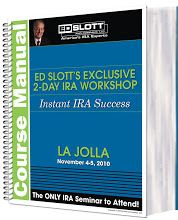It is another busy week at The Slott Report Mailbag with a pair consumer questions and our answers. As always, we stress the importance of working with a competent, educated financial advisor to keep your retirement nest egg safe and secure.
1.
Hello Ed Slott and Company,
I currently have my traditional IRA account and my first RMD (required minimum distribution) is due this year. I'm single with no dependents. My IRA value is worth $346,000. My question is, "Is there anything that I can do at this time to reduce my RMD tax burden in the foreseeable future?"
Many thanks,
Michael Walsh
Hollywood, FL
Answer:
Your marital status has no bearing on your RMD. All account owners use the same table, the Uniform Lifetime Table, for calculating the RMD unless their spouse is more than 10 years younger, in which case they use the Joint Lifetime Table. You could reduce your RMD by marrying someone more than 10 years younger than you and naming them as the beneficiary of your IRA. Your only other option to reduce RMDs would be to convert all or part of your IRA to a Roth IRA. You would pay the tax upfront, but in future years you would have no RMDs from the Roth account and whatever you took out of the Roth after 5 years would all be income tax free. The RMD amount cannot be converted; it must be withdrawn before doing a conversion. Other types of tax planning can be one with investments you hold outside of the IRA to generate tax-free income or to generate deductions to reduce your overall income, and thus the taxes owed.
2.
I need to know when an IRA owner dies, what is the IRS timeline for when the beneficiary needs to take receipt of the funds, i.e. distribution or rollover to an inherited IRA?
Thank you,
Jim Allen
Answer:
An IRA inherited by a non-spouse beneficiary cannot be moved via a 60-day rollover. It can only be moved as a trustee-to-trustee (direct transfer or direct rollover) transfer between accounts. Any distribution payable to a non-spouse beneficiary is a taxable event and there is no fix for this. Most custodians like to get the assets moved to the inherited account as soon as possible, usually before any distributions are made to a beneficiary. This is so that distributions go out using the correct Social Security number. When there are multiple beneficiaries on an inherited account, the tax code says that the account should be split into separate inherited IRAs by the end of the year after the account owner's death in order for each beneficiary to use their own life expectancy.
If there is only one beneficiary, there really is no deadline for getting the IRA assets into an inherited account. The first distribution based on the beneficiary's life expectancy must be taken by the end of the year after the account owner's death. If the beneficiary must (or chooses to) use the 5-year rule, then there are no required distributions during the five year period. The only requirement is that the account must be emptied by the end of the fifth year following the year of the account owner's death. The beneficiaries distribution options are dependent on the tax code and ultimately on the options allowed in the IRA agreement.
By IRA Technical Consultant Marvin Rotenberg and Jared Trexler
------------------------------------------------------------------------------
Comment, Question, Discussion Topic on your mind? Click on the Blue Comment Link below and leave your thoughts then check back to see what other consumers and advisors think.
*Copyright 2010 Ed Slott and Company, LLC
Thursday, August 5, 2010
RMDs and Inherited IRAs Highlight Mailbag
Quality content
- Siti Non Aams
- Nuovi Siti Casino
- Casino Non Aams Italia
- Casinos Not On Gamstop
- Casino Sites Not On Gamstop
- Online Casino
- UK Casino Not On Gamstop
- Sites Not On Gamstop
- Casino En Ligne
- Casino En Ligne Fiable
- Casinos Not On Gamstop
- UK Casino Not On Gamstop
- Casino Sites Not On Gamstop
- Non Gamstop Casinos UK
- Casino Online Non Aams
- Casino Not On Gamstop
- Meilleur Casino En Ligne France
- Casino Sites Not On Gamstop
- Non Gamstop Casino Sites UK
- Casino Sites UK Not On Gamstop
- UK Casino Not On Gamstop
- Meilleur Casino En Ligne Fiable
- Casino Online Non Aams
- Casino Non Aams
- Casino Sites Not On Gamstop
- Meilleur Casino En Ligne Belgique
- Lista Casino Online Non Aams
- 안전한 파워볼사이트
- Meilleur Casino En Ligne 2026
- Meilleur Casino En Ligne 2026
Subscribe to:
Post Comments (Atom)
















1 comments:
To the RMD question - taxes are going to hit one way or another. A withdrawal or conversion.
I encourage people to review their income tax return to understand their marginal rate. Here's an example -
In 2010 the 15% rate ends at $34,000 taxable income (after deductions, exemptions, etc.) I help an 80 yr old woman who, including her RMD, would be at about $25,000 taxable. So this year we will convert $9000 to Roth, taxed at 15%, but no more. This strategy helps keep the RMDs from accelerating and pushing her to the 25% bracket.
Post a Comment